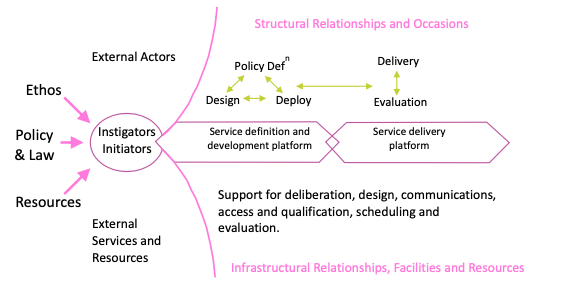Co-Creation of Service Model
This model is designed to encourage its users to put their local initiative into a wider structural and infrastructural context and to consider the ongoing relationships between the activities they have undertaken and this relevant external considerations.
The Co-Creation of Service Model emerged from a consideration several Social Innovations and is an attempt, on the one hand, to identify the core internal elements that are common to all the various approaches of them and, on the other, to make certain key external elements and factors which, are relevant to any service environment, explicit if it is to be sustainable. It represents an attempt to present and interrelate a number of terms and categories to provide the basis for a common language and framing of the service innovations activities.
The service process model below is included in this model as a set of Structural Relationships and Occasions. Each pilot can populate some or all of these processes with the identities of actual participants. For example, as we have seen, in some cases, Policy has represented an external input to which the pilot has had to respond whereas in others, policy was generated internally.
The service life-cycle processes are distributed over, and supported by, a service definition and development platform and a service delivery platform. For example, a social hackathon represents such a definition and development platform. The nature of the delivery platform for any service or service set defined in a hackathon is one of the outputs of the co-creation process. In the another case, the business development support facility has been both service definition and development as well as the delivery platform.
The reason for introducing these concepts is to encourage discussion about reusable infrastructure which is able to support and sustain successive initiative in co-creative service development which is an important element of sustainability through growth and diversification. Having identified an abstract, generic model of co-creation and of service, we have created the opportunity for shared resources between co-creation initiatives and services. Thus, below the platform we have a space in which to locate infrastructural capacities to support deliberation, design, communications, the means of access to different sorts of services and service components and for the processes of qualification, scheduling and evaluation. The precise shape and nature of these resources will vary from pilot to pilot but there are some universal elements that are common requirements in many classes of wellbeing and developmental services. Many of these are concerned with the support of information management and communication, such as publication channels, registration services by which new actors and resources which join the service environment can be given identifiers and locators, catalogue publication and management and recording and profiling tools. The description so far has covered the right-hand part of the model above. This represents elements that are considered to be within the co-creative ethos of a pilot’s actions. The left-hand side of the model represents relevant external elements that are part of the initiation of such a process or have some ongoing impact on it.

